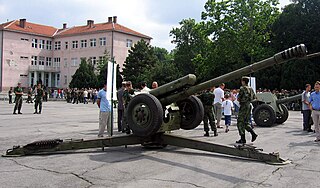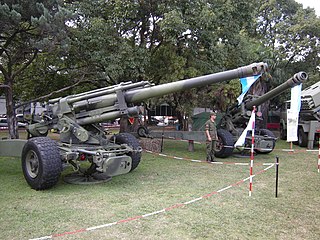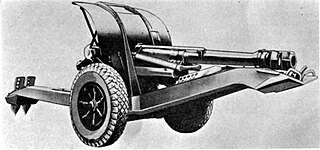 W
WThe 2S9 NONA is an extremely light-weight self-propelled and air-droppable 120 mm gun-mortar designed in the Soviet Union, which entered service in 1981. The 2S9 chassis is designated the S-120 and based on the aluminium hull of the BTR-D airborne multi-purpose tracked armoured personnel carrier. More generally, the 120 mm mortar is referred to as the Nona, with the 2S9 also known as the Nona-S. Although no figures have been released, it is estimated that well over 1,000 2S9 were built.
 W
WThe 85 mm vz. 52 was a dual-purpose field gun and anti-tank gun designed and produced for the Czechoslovak Army during the 1950s.
 W
WThe 100 mm field gun M1944 (BS-3) was a Soviet 100 mm anti-tank and field gun. The gun was successfully employed in the late stages of World War II, and remained in service into the 1950s, being replaced in Soviet service by the T-12 antitank gun and the 85 mm antitank gun D-48 in 1955. The BS-3 was also sold to a number of other countries and in some of these countries the gun is still in service. A number of BS-3 pieces are still stored in Russian Ground Forces arsenals. Also, in 2012, at least 12 BS-3 guns are active with the 18th Machine Gun Artillery Division, located on the Kuril Islands, used as anti-ship and anti-landing guns.
 W
WThe 100 mm vz. 53 was a dual-purpose field gun and anti-tank gun designed and produced for the Czechoslovak Army during the 1950s.
 W
WThe 122-mm howitzer D-30 is a Soviet howitzer that first entered service in 1960. It is a robust piece that focuses on the essential features of a towed field gun suitable for all conditions. The D-30 has a maximum range of 15.4 kilometers, or over 21 km using RAP ammunition.
 W
WThe 130 mm towed field gun M-46 is a manually loaded, towed 130 mm artillery piece, manufactured in the Soviet Union in the 1950s. It was first observed by the west in 1954.
 W
WThe 152 mm gun-howitzer M1955, also known as the D-20, is a manually loaded, towed 152 mm artillery piece, manufactured in the Soviet Union during the 1950s. It was first observed by the west in 1955, at which time it was designated the M1955. Its GRAU index is 52-P-546.
 W
WThe Bateleur is a South African self-propelled multiple rocket launcher. It is a 127mm system with a wheeled launcher vehicle, disposable pods, and fire control equipment developed by Denel Land Systems. Based on a mine protected Kwêvoël 100 10 ton 6x6 carrier. Its mission is to engage in counter-battery strikes against hostile artillery and air defences as far as 36 km (22 mi) away. Other potential warheads include cluster and an anti-tank mine dispenser. The weapon can fire up to 40 127mm pre-fragmented high explosive warheads to ranges of 7.5km to 36km at sea level singly or using ripple fire, firing up to 1 rocket per second. Reload can take less than 10 minutes and in/out-of-action time is one and two minutes respectively. The system is supported by a Kwêvoël 100 ammunition truck carrying 96 rockets and crew who help with the reloading.
 W
WThe 155mm L45 CALA 30 Gun is an Argentinian long range field artillery system developed for and in limited service with the Argentine Army.
 W
WThe 155mm L33 Argentine Model gun is an Argentinian artillery field gun in service with the Argentine Army.
 W
WThe 122mm D-74 towed gun is a Soviet-built gun. Developed in the late 1950s it provided direct and indirect fire for the Soviet Army. Today it is in reserve units with the Russian Army.
 W
WThe G5 is a South African towed howitzer of 155 mm calibre developed in South Africa by Denel Land Systems. The G5 design was based on the Canadian GC-45 155mm gun which was highly modified to suit southern African conditions.
 W
WThe GC-45 is a 155 mm howitzer designed by Gerald Bull's Space Research Corporation (SRC) in the 1970s. Versions were produced by a number of companies during the 1980s, notably in Austria and South Africa.
 W
WThe L118 Light Gun is a 105 mm towed howitzer. It was originally produced for the British Army in the 1970s and has been widely exported since, including to the United States, where a modified version is known as the "M119 howitzer".
 W
WThe 105 mm M101A1 howitzer is an artillery piece developed and used by the United States. It was the standard U.S. light field howitzer in World War II and saw action in both the European and Pacific theaters. Entering production in 1941, it quickly gained a reputation for accuracy and a powerful punch. The M101A1 fires 105 mm high explosive (HE) semi-fixed ammunition and has a range of 12,330 yards (11,270 m), making it suitable for supporting infantry.
 W
WThe M102 is a light, towable 105 mm howitzer used by the United States Army in the Vietnam War, the First Gulf War, and the Iraq War.
 W
WThe Obusier de 105 modèle 1950 was a French Howitzer designed and built after World War II for the French Army.
 W
WObusier de 155 mm Modèle 50 was a French 155 mm 30 calibre howitzer introduced in 1952. The first French artillery designed since World War II, it was manufactured in both France - 980 howitzers were produced - and under license in Sweden for the Swedish armed forces. The Model 50 was replaced in French service during the 1980s by the TRF1.Reserve units were produced until the end of the 1990s.
 W
WThe Ordnance QF 25-pounder, or more simply 25-pounder or 25-pdr, was the major British field gun and howitzer during the Second World War, possessing a 3.45-inch (87.6 mm) calibre. It was introduced into service just before the war started, combining both high-angle and direct-fire abilities, a relatively high rate of fire, and a reasonably lethal shell in a highly mobile piece. It remained the British Army's primary artillery field piece well into the 1960s, with smaller numbers serving in training units until the 1980s. Many Commonwealth of Nations countries used theirs in active or reserve service until about the 1970s and ammunition for the weapon is currently being produced by Pakistan Ordnance Factories. Initial production was slow, but by 1945, over 12,000 had been manufactured. The 25-pounder was probably the most outstanding field artillery piece used by British and Commonwealth forces in the Second World War, being durable, easy to operate and versatile.
 W
WThe OTO-Melara Mod 56 is an Italian-made 105 mm pack howitzer built and developed by OTO-Melara. It fires the standard US type M1 ammunition.
 W
WThe Type 83 122 mm howitzer is a towed howitzer used by the People's Liberation Army of China. The gun system is developed from the earlier Chinese Type 54 howitzer which was in turn developed from the Soviet 122 mm howitzer M1938 (M-30).
 W
WThe Valkiri is a South African self-propelled multiple rocket launcher. It is a 127mm system with a wheeled launcher vehicle, disposable pods, and fire control equipment developed by Denel Land Systems. Contemporary models consist of a single launch module with five eight-cell rocket pods on a Unimog or SAMIL-100 carrier. Its mission is to engage in counter-battery strikes against hostile artillery and air defences as far as 36 km (22 mi) away. Other potential warheads include cluster and an anti-tank mine dispenser.